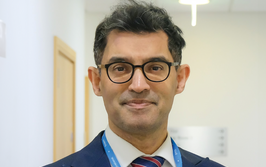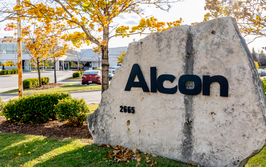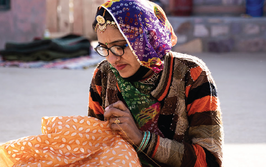A Question of Capacity
How Seva plans to add another million sight-saving surgeries in developing countries per year by 2020
At a Glance
- Preventable blindness is on the rise globally, according to new data from the Vision Loss Expert Group; there are clear and specific actions that can be taken to change this trajectory
- Approaching its fortieth anniversary, Seva Foundation is increasing capacity in eye care facilities around the world through its Global Sight Initiative (GSI), so that an additional one million people will receive sight-restoring surgery every year by 2020.
- Ophthalmologist Marty Spencer, long-time Seva board member, talks about his volunteer work with Seva, training local eye care professionals and introducing new technologies to eye care facilities in developing countries
- Seva’s cultural competence model of building local capacity where cataract surgery takes 15 minutes, costs $50, and is offered on a sliding scale to patients should help local eye care facilities become self-sustainable within 5 to 10 years
A recent paper in the Lancet from the Vision Loss Expert Group (VLEG) conveys sobering data about the projected increase in blindness worldwide over the next 30 years. “Global causes of blindness and distance vision impairment 1990–2020: a systematic review and meta-analysis,” (1) found that there are 253 million people worldwide with vision impairment, including 36 million who are blind and 217 million with moderate or severe visual impairment (MSVI). A full 89 percent of visually-impaired people live in low and middle-income countries.
The authors of the study estimated that 81 percent of visual impairment (blindness and MSVI combined) is avoidable. In this case, “avoidable” includes cataract and uncorrected refractive error, the two conditions included in the World Health Organization’s Global Action Plan. It also encompasses trachoma, glaucoma, diabetic retinopathy and corneal opacity.
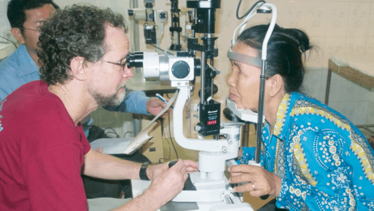
Marty Spencer in the field with Seva.
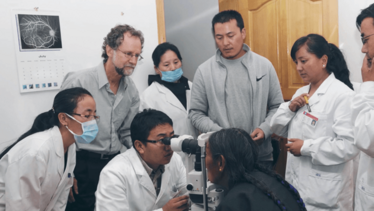
Marty Spencer (top left) training eye care professionals at a Seva partner facility.
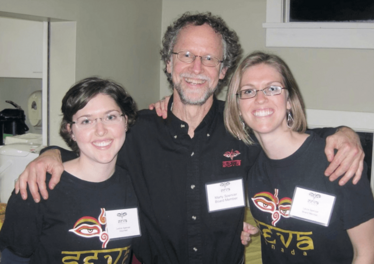
Marty (center) with his daughters Laura (left), Chair of the Board of Seva Canada and Justine, a volunteer for Seva Canada.
Additionally, the VLEG study found that the prevalence of visual impairment has been dropping over the last 25 years, from 4.6 percent in 1990 to 3.4 percent in 2015. That’s the good news. But there’s also bad news; the study forecasts that various global trends, including population increase and ageing, threaten to overwhelm our existing efforts. Applying the new VLEG data, the International Agency for the Prevention of Blindness (IAPB)’s new Vision Atlas (2) projects a threefold increase in avoidable vision impairment by 2050.
These trends can seem discouraging, but within them is a kernel of hope. Because so many of the vision-related challenges are treatable or preventable, there are clear and specific actions that can be taken to change the trajectory. I have volunteered for many years with the Seva Foundation, delivering cataract surgery training and technology to underserved regions of the globe. Groups like Seva are pioneering cost-effective and sustainable solutions that will bring us much closer to a world free of avoidable blindness, perhaps someday much closer than we might imagine.
Seva was founded 40 years ago to address the problem of preventable and curable blindness. Since that time, the foundation has been developing and perfecting the technological, capacity-building and outreach methodologies for delivering sight-saving and sight-restoring services in underserved regions throughout the world. Through its Global Sight Initiative (GSI), Seva plans to increase capacity in eye care facilities around the world so that an additional one million people annually will receive sight-saving surgery by 2020.
A sustainable model
GSI pairs established, successful mentor eye hospitals with mentee hospitals in need of training and support. Through this support, one mentee hospital in the GSI network has increased its annual capacity for performing cataract surgeries from 4,000 nine years ago to 10,000 today. If the 94 hospitals currently receiving mentorship match that output – which is a feasible goal, based on past performance – together they would get us more than halfway to the global goal of one-million additional cataract surgeries a year.
There’s cause for more hope. These current GSI mentee hospitals only cover a small portion of the low- and middle-income countries of the world: a handful in Central America and the Caribbean, fewer than ten in Africa, several in Nepal, and the bulk of them in various locations in India. An expansion of this network of mentor and mentee eye hospitals could exponentially increase the number of people receiving eye care.
Along with GSI’s hospital network, Seva provides funding, support, and critical capacity-building to eye care centers in numerous locations around the world. This “teach a man to fish” model has proved enormously successful. The locally-run eye care programs Seva partners with generally become self-sustaining within five to ten years. In many cases, this is done by using multi-tier payments systems, where one-third of a facility’s patients subsidize care for the other two-thirds.
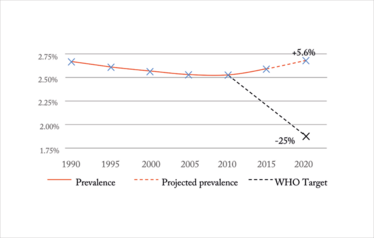
Changes in the global prevalence of avoidable visual impairment, 1990–2015 and projections to 2020 (2).
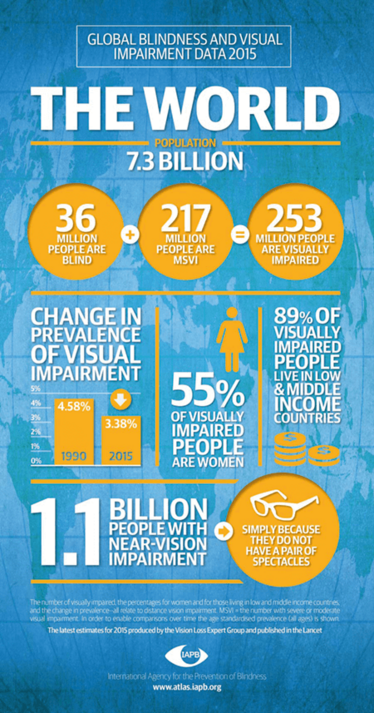
Global blindness and visual impairment data 2015 (Source: IAPB Vision Atlas).
The role of volunteers
A key aspect of this model is access to low-cost, but still high-quality, materials and techniques. Seva has played a crucial role in the development of several innovations in eye care delivery in underserved regions. Volunteer ophthalmologists and other eye care providers play a key role in keeping local providers aware of and trained in the latest medical innovations.
For example, I introduced manual sutureless cataract surgery in several countries over the past 20 years. Another Seva board member, Dick Litwin, introduced the use of intraocular lenses (IOLs) for cataract surgery in India back in the early 1980s. At first, as IOLs were going through developmental iterations in the West, Seva obtained the outdated models – which were still perfectly viable – for their partner eye hospitals in India and Nepal. Each lens cost $300 at that time in the U.S., but came free to Seva, enabling their partners to offer free cataract surgery to those in need.
As IOL technology stabilized, the supply of free lenses dried up, and so Seva and its sister organization, Seva Canada, provided the impetus for what eventually became Aurolab. Now the manufacturing division of Aravind Eye Hospital in Tamil Nadu, India, Aurolab makes IOLs and other ophthalmic consumables, such as surgical sutures, pharmaceutical products, surgical blades and other equipment. Producing high-quality supplies in-country, with quality and cost controls, has been a major factor in the spread of free cataract surgery to people in need. The current cost of sight-restoring cataract surgery performed at Seva-partner eye camps and hospitals is only $50 – and that price includes both materials and surgical staff required to perform the procedure.
Cultural competence
Adapting teaching and service techniques to the particular needs and cultures of various developing nations has also contributed immensely to expanding the volume and quality of eye care worldwide. When Litwin first traveled to India, the person he shared those IOL prototypes with was Venkataswamy, a founding board member of Seva and the force behind Aravind Eye Hospital. At that time, Aravind had already created a successful model of delivering high-volume, high-quality, low-cost eye care in rural regions of India. Seva’s founders realized this model could be adapted to different countries in culturally-appropriate ways.
Seva has a long history of connecting ophthalmologists and other eye care medical professionals with their newly-discovered life’s calling of helping people to see. This was certainly the case for me. My avocation for the past 30 years has been alleviating and preventing blindness in developing countries – work that has been extremely meaningful to me. I invite everyone working in the field of eye health to consider contributing their time and talents to this global effort. There are myriad opportunities to do so. For example, I recently volunteered a week’s time training at a center in Latin America and traveled to provide and demonstrate services in rural Nepal.
With its global network, volunteer force of ophthalmologists, eye care nurses and other medical professionals, and its strong donor base, Seva Foundation is strongly positioned to provide sight-saving and sight-restoring services to more people in more places around the globe in the decades to come. The challenges, as evidenced by the latest data from VLEG, are daunting. But Seva and their governmental and non-profit compatriots in the field of reducing global blindness have made enormous strides. Seva’s four decades of experience are serving as a hopeful springboard to launch the next phase of the work. We go forward with a 20/20 vision of a world where all can see.
Marty Spencer sits on the Board of Directors of Seva Foundation and Seva Canada. He has received the Governor General’s Medal for Volunteers Award from the Canadian Government for his commitment and service to prevent blindness and restore sight around the world.
- SR Flaxman et al., “Global causes of blindness and distance vision impairment 1990-202: a systematic review and meta-analysis”, Lancet Global Health, 5, e1221–e1234 (2017). PMID: 29032195.
- International Agency for the Prevention of Blindness, Vision Atlas, Available at atlas.iapb.org. Last accessed February 21, 2018.
Spencer sits on the Board of Directors of Seva Foundation and Seva Canada. He has received the Governor General’s Medal for Volunteers Award from the Canadian Government for his commitment and service to prevent blindness and restore sight around the world.

